East Junction Branch
The East Junction Branch (formerly known as the India Point Branch) is a rail line in Rhode Island and Massachusetts, in the United States. The line branches off the Northeast Corridor at Attleboro, Massachusetts, at a point known as East Junction, and ends at the East Providence Branch in East Providence, Rhode Island. CSX Transportation operates freight service on the branch in Attleboro, while the Providence and Worcester Railroad operates freight service in East Providence and across the state line into Seekonk. The line is owned by the P&W in Rhode Island, and by the Massachusetts Bay Transportation Authority in Massachusetts.
| East Junction Branch | |||
|---|---|---|---|
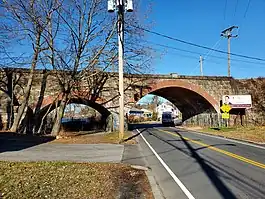 View of the Boston and Providence Railroad Bridge which carries the East Junction Branch over the Ten Mile River in Rumford, Rhode Island | |||
| Overview | |||
| Owner | MassDOT, Providence and Worcester Railroad | ||
| Locale | Bristol County and Providence County | ||
| Termini | |||
| Connecting lines | East Providence Branch, Northeast Corridor | ||
| Former connections | Providence, Warren and Bristol Railroad | ||
| Service | |||
| Operator(s) | CSX Transportation (Attleboro) Providence and Worcester Railroad (East Providence and Seekonk) | ||
| History | |||
| Opened | 1835 | ||
| Technical | |||
| Line length | 6.23 mi (10.03 km), line formerly 7.69 mi (12.38 km) | ||
| Track gauge | 4 ft 8+1⁄2 in (1,435 mm) | ||
| Electrification | Overhead line, 600 V DC (electrified between 1900-1934 on the portion south of the Crook Point Bascule Bridge for New Haven trains) | ||
| |||
The East Junction Branch was originally built as part of the Boston and Providence Railroad's (B&P) main line between its namesake cities, entering the India Point neighborhood of Providence, Rhode Island, via the India Point Railroad Bridge across the Seekonk River. This was one of the first railroad lines in the United States when completed in 1835. A new main line into Providence was built in conjunction with the Providence and Worcester Railroad in 1847, bypassing the original main line which was designated as a branch. The ill-fated Seekonk Branch Railroad built a short branch off the East Junction Branch within East Providence (then part of Seekonk), which was soon purchased by the B&P and later used as part of the Providence, Warren and Bristol Railroad when that railroad opened in 1855. The P&W completed its East Providence Branch in 1874, which originated in Valley Falls and met the East Junction Branch in East Providence.
The B&P was succeeded by the Old Colony Railroad in 1888, which was itself taken over by the New York, New Haven and Hartford Railroad (the New Haven) in 1893. The Crook Point Bascule Bridge was completed in 1908 along with the East Side Railroad Tunnel, allowing a new route from the East Junction Branch into Providence.
Passenger service was suspended after Penn Central Transportation Company absorbed the New Haven in 1969. The India Point Railroad Bridge was decommissioned in 1974, cutting the East Junction Branch back to East Providence, and the Crook Point Bascule Bridge followed in 1976. The bankrupt Penn Central was merged into government-formed Conrail in 1976, and the newly-independent P&W was assigned operation of the East Junction Branch within Rhode Island, with Conrail retaining operations in Massachusetts. After CSX Transportation took over from Conrail in 1999, much of the Massachusetts portion was placed out of service in 2001; P&W reactivated some of this trackage in Seekonk to serve a new customer in 2007. The actively used Boston and Providence Railroad Bridge in East Providence is listed on the National Register of Historic Places.
History
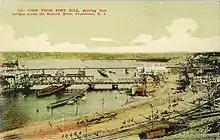
The East Junction Branch is part of the original Boston and Providence Railroad (B&P), opened in 1835.[1] To reach Providence from Boston, the B&P chose a largely straight route that avoided curves; it was a straight shot southwest from Mansfield, Massachusetts to what was then part of Seekonk, Massachusetts, (later transferred to Rhode Island as East Providence). Seekonk was just across the Seekonk River from Providence, and a ferry initially made the final leg of the trip into the city until a wooden drawbridge, the first of several incarnations of the India Point Railroad Bridge, was completed and allowed trains to enter India Point.[2] The B&P was joined in Providence by the New York, Providence and Boston Railroad in 1837, but the two lines did not directly meet. Ferries ran from India Point to the South Side of Providence to allow passengers to transfer trains.[3]
Once the railroad bridge was completed, the B&P found itself in conflict with another company: the Seekonk Branch Railroad, chartered in 1836 to build a railroad between the B&P in Seekonk and a wharf on the Seekonk River. The Seekonk Branch Railroad intended to use the B&P bridge to run its own trains into Providence, treating the route much like a toll road. However, the Massachusetts General Court refused to permit this, requiring Seekonk Branch Railroad trains be hauled by Boston and Providence Railroad locomotives into Providence.[4] In 1839, the Boston and Providence Railroad absorbed the Seekonk Branch Railroad.[5]
Providence's third railroad, the Providence and Worcester Railroad, opened between its namesake cities in 1847. The P&W and B&P collaborated on a new joint line out of Providence which split in Central Falls, Rhode Island; the B&P built a new mainline from that point to its original main line in Attleboro. The new route became the primary line out of Boston, while the original route into Providence was retained as a branch line, named the East Junction Branch for the point where the new route split from the old one. Made largely redundant by the new route into Providence, most passenger service was dropped at this time apart from trains meeting steamboats at India Point.[6]
The Providence, Warren and Bristol Railroad was completed in 1855, connecting to the East Junction Branch in Seekonk (today East Providence). The bridge across the Seekonk River was initially used by the PW&B to reach Providence via trackage rights. Per the PW&B charter, the railroad also had the right to connect with Boston and Providence Railroad passenger trains in Seekonk to provide service to Boston, but this was not taken advantage of.[7]
Upon its completion in 1874, the P&W's East Providence Branch connected with the East Junction Branch in East Providence, then followed the PW&B right of way to Bold Point.[8]
Passenger train service resumed on the branch circa 1880.[9]
The area of Seekonk that banked the Seekonk River was reincorporated as East Providence, Rhode Island as part of a boundary settlement between the two states in 1862; this would effectively split the line between the two states.[10]
Operations under Old Colony and New Haven
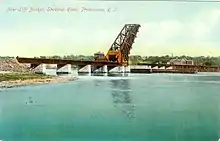
The B&P was leased by the Old Colony Railroad in 1888 and the line was labeled as the India Point Branch. The New York, New Haven and Hartford Railroad leased the Old Colony in 1893.
The electrification of the Providence, Warren & Bristol in 1900 increased the feasibility of a mile-long tunnel under College Hill to provide a way of getting trains from the east bay to Union Station in the center of Providence and an alternate route to Boston. The Crook Point Bascule Bridge along with the East Side Tunnel and a downtown viaduct were put into service on November 15, 1908.[11]
By 1903, passenger service was provided by a single combination baggage/passenger car pulled by a steam locomotive, which ran two round trips daily between East Providence and East Junction. The only regular stop was at Rumford, while a flag stop was also maintained at Perrin's. Passenger numbers averaged in the single digits per trip, and sometimes the train ran with no passengers at all; tickets could not be purchased in Providence and the Providence Journal attested that most local residents were unaware the passenger train was available. This train continued running to fulfil the New Haven's requirement to provide passenger service on the line, which held far more value as a route for freight trains.[12]
The New Haven sought to double-track the branch between East Providence and East Junction, and approval for this work along with the elimination of several grade crossings came in October 1912. This was intended to allow for a continuous double-tracked route from East Junction to the Crook Point Bridge.[13] This work was budgeted at $405,000 in 1910.[14] As part of the construction, Rumford station was to be moved approximately 500 feet east. Pawtucket Avenue (Rhode Island Route 114 / U.S. Route 1A) was to be grade-separated with a new bridge.[13] Double tracking was completed by November 1913.[15]
Regular passenger service was discontinued by 1914. While regular passenger service never returned to the branch, dedicated passenger trains connecting to Narragansett Park were introduced by 1937 and continued until the end of the New Haven Railroad in 1968.[9]
Decline
In 1969 the New Haven was merged into Penn Central Transportation; soon thereafter, all passenger services between Union Station via the East Junction branch ceased.[16] The MBTA acquired the piece in Massachusetts on January 27, 1973, despite it not seeing any passenger service.[17] The newly independent Providence and Worcester Railroad assumed operations on the Rhode Island portion of the branch in 1976, while PC successor Conrail inherited freight rights on the Massachusetts portion.[18]
When Rhode Island ended passenger rail subsidies for MBTA services to Providence in 1981, a potential commuter rail extension of the Attleboro line to a new terminus near Newman Avenue in Seekonk via the East Junction Branch was briefly considered. Service subsidies to Rhode Island were restored in 1988 which negated the need for a Seekonk station; north Seekonk would instead be serviced by South Attleboro station which opened along the Northeast Corridor in 1990.
The line from Wilkesbarre Pier to Bristol was officially abandoned in 1976 due to low freight demand. That same year, the Crook Point Bascule Bridge, East Side Tunnel, and India Point Bridge were also abandoned.[19] The east side viaduct was demolished when the Northeast Corridor was re-routed to facilitate remodeling of the downtown area of Providence in the early 1980s; Providence Station would replace the old Union Station in 1986.
Current operations and route
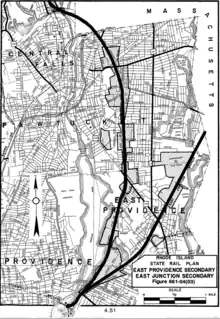
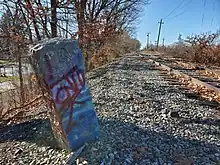
The branch breaks from the Northeast Corridor at East Junction in Attleboro; an MBTA yard was formerly located at the junction. The branch travels southward through rural areas of Seekonk before entering Pawtucket where it crosses the Ten Mile River in Slater Park. The line continues into Rumford where it crosses the Boston and Providence Railroad Bridge; the branch then curves westward and connects to the East Providence Branch via a new track built by the P&W in 2006.
Freight would continue to service a scrapyard at Wilkesbarre Pier until the early 2000s.[20] CSX placed most of the Seekonk portion of the branch out of service in 2001 excluding the northernmost portion in Attleboro where an active customer remained; this 1.81 mile segment has remained in a state of neglect for over twenty years despite the line being considered active.[18] In 2006, the final half of a mile in East Providence was abandoned by the P&W, with a new connection built to the East Providence Branch. P&W continued to serve only the Rhode Island portion of the East Junction Branch until 2007, when a metals customer north of Newman Avenue in Seekonk asked for renewed rail service. P&W returned the line to service into Seekonk for the new customer that year.[18]
Former stations
There are no physical remnants of any station sites on the East Junction Branch. Several stations were either relocated to the new B&P mainline, cut early on or consolidated due to the emergence of streetcars in Pawtucket and East Providence.
| Location | Station | Milepost (km) | Image | Notes |
|---|---|---|---|---|
| Attleborough | East Junction | 0 (0) | Junction with Boston and Providence main line; station would have mainly served as a freight depot | |
| Seekonk | Perrins | 1.7 (2.7) | ||
| Pawtucket | Daggett | 3.5 (5.6) | ||
| Narragansett Park | 3.7 (5.9) | 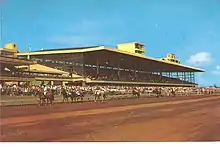 |
Served the Narragansett Park Horse Track until the late 1960s; it was likely the last passenger stop to remain operational on the branch | |
| East Providence | Rumford | 5.2 (8.3) | ||
| Waterman Avenue | 6.7 (10.7) | Junction with Providence and Worcester line; an interlocking station was constructed at this site | ||
| East Providence | 7.4 (11.8) | 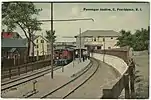 |
Crosses Seekonk River at India Point; crossing moved north in 1908 with opening of East Side Railroad Tunnel and was the junction with the Providence-Bristol line |
Gallery
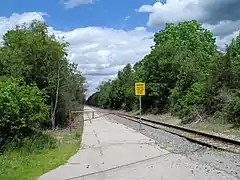 View of the access road for the MBTA layover yard at East Junction; this section of track is currently disused
View of the access road for the MBTA layover yard at East Junction; this section of track is currently disused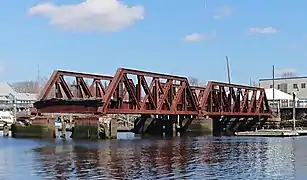 Former trusses of the former India Point Rail Bridge. The remaining trusses were removed in Spring 2023
Former trusses of the former India Point Rail Bridge. The remaining trusses were removed in Spring 2023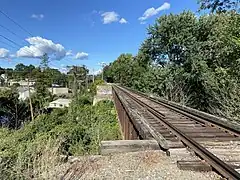 Top view of girder span of the Boston and Providence Railroad Bridge
Top view of girder span of the Boston and Providence Railroad Bridge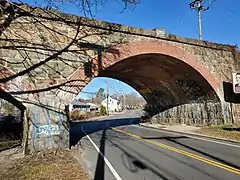 Main arch of the B&P rail bridge; it is one of only three remaining original B&P built structures
Main arch of the B&P rail bridge; it is one of only three remaining original B&P built structures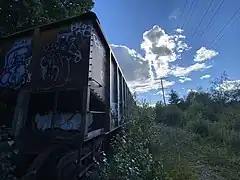 View of abandoned hopper cars along the East Providence section; the cars were removed in early 2022
View of abandoned hopper cars along the East Providence section; the cars were removed in early 2022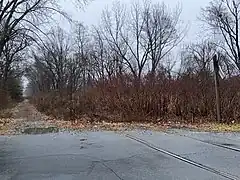 Location of the former Perrins station site in Seekonk; this section of track is currently out of service and not maintained
Location of the former Perrins station site in Seekonk; this section of track is currently out of service and not maintained
Notes
- "PRR Chronology, 1835" (PDF). (95.9 KiB), June 2004 Edition
- Karr 2017, pp. 175–177.
- Karr 2017, p. 177.
- Massachusetts Senate Committee on Railways and Canals (1838). Report and Bill on the Petition of the Seekonk Branch Rail-Road Company (Report). pp. 3–5, 36–38.
- Massachusetts General Court Joint Standing Committee on Railways and Canals (1849). Annual Reports of the Railroad Corporations in the State of Massachusetts For 1848 (Report). Boston: Dutton and Wentworth, State Printers. pp. 196–197.
- Karr 2017, pp. 177–178, 182–183.
- Heppner 2012, pp. 103–104.
- Karr 2017, p. 169.
- Karr 2017, pp. 182–183.
- "RHODE ISLAND RAILROADS - EAST PROVIDENCE NORTH". sites.google.com. Retrieved 2022-11-19.
- Scherzer, Albert H. Scherzer Rolling Lift Bridges. 1908. Chicago: Scherzer Rolling Lift Bridge Co. of Chicago
- "Two Branch Railroads Near the Centre of East Providence". Manufacturers' and Farmers' Journal. October 22, 1903. p. 8.
- "Hearing Announced". The Sunday Tribune. Providence, Rhode Island. October 27, 1912. p. 27.
- Interstate Commerce Commission (December 21, 1910). Evidence Taken by the Interstate Commerce Commission in the Matter of Proposed Advances in Freight Rates by Carriers (Report). Vol. 9. Washington: Government Printing Office. p. 5307.
- "New York, New Haven & Hartford RR. Abstracts from Forty-Second General Statement–For the Year Ended June 30, 1913". The Statist. 78: 384–385. November 15, 1913 – via Google Books.
- "PRR Chronology, 1969" (PDF). (80.5 KiB), June 2004 Edition
- Jonathan Belcher, "Changes to Transit Service in the MBTA district 1964-2006" (PDF)., October 4, 2006 version
- Karr 2017, p. 183.
- "Railroad bridge's days numbered". Providence Journal. 14 September 2001. Retrieved 16 March 2014.
- Dujardin, Richard. "Visions of a new East Providence waterfront". 13 July 2003
References
- Heppner, Frank H. (2012). Railroads of Rhode Island : shaping the Ocean State's railways. Charleston, South Carolina: History Press. ISBN 978-1614233633. OCLC 841413913.
- Karr, Ronald Dale (2017). The Rail Lines of Southern New England (2nd ed.). Pepperell, Massachusetts: Branch Line Press. ISBN 978-0942147124. OCLC 1038017689. Archived from the original on October 24, 2021. Retrieved October 22, 2021.
External links
![]() Media related to East Junction Branch at Wikimedia Commons
Media related to East Junction Branch at Wikimedia Commons